Showing Spotlights 9 - 16 of 68 in category All (newest first):
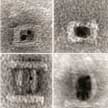 DNA is probably the most programmable biomaterial for creating a wide range of rationally designed and functionally enhanced nanostructures. The sophisticated, programmable, and addressable DNA nanostructures are strong candidates for constructing nanoelectronic devices. The size of DNA molecules is also key: DNA double-helix has a neighboring base pair distance of 0.34 nm and a diameter of 2.1 - 2.6 nm a, and thus DNA complex-based nanoelectronics may break the 5-nm processing limit of commercial silicon-based semiconductors.
DNA is probably the most programmable biomaterial for creating a wide range of rationally designed and functionally enhanced nanostructures. The sophisticated, programmable, and addressable DNA nanostructures are strong candidates for constructing nanoelectronic devices. The size of DNA molecules is also key: DNA double-helix has a neighboring base pair distance of 0.34 nm and a diameter of 2.1 - 2.6 nm a, and thus DNA complex-based nanoelectronics may break the 5-nm processing limit of commercial silicon-based semiconductors.
Sep 10th, 2020
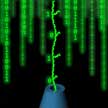 Using DNA to directly store data is an attractive possibility because it is extremely dense and long-lasting. Currently, though, synthesizing and sequencing DNA molecules for storing large amounts of data involves complex devices and is very expensive. In an effort to make data storage in DNA more affordable and commercially viable, researchers have combined nanopore sensing and DNA nanotechnology in a solid-state nanopore platform for digital data storage. This digital data storage method provides an alternative to information storage in the DNA base sequence.
Using DNA to directly store data is an attractive possibility because it is extremely dense and long-lasting. Currently, though, synthesizing and sequencing DNA molecules for storing large amounts of data involves complex devices and is very expensive. In an effort to make data storage in DNA more affordable and commercially viable, researchers have combined nanopore sensing and DNA nanotechnology in a solid-state nanopore platform for digital data storage. This digital data storage method provides an alternative to information storage in the DNA base sequence.
Jan 15th, 2019
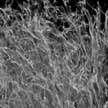 Investigating the potential of DNA to form self-assembled injectable hydrogels via physical crosslinking with silicate nanodisks, researchers have utilized DNA as a high molecular weight polymeric chain in order to form hydrogel networks for tissue regeneration and drug delivery applications. They have designed shear thinning hydrogels, which can be passed through a 22-gauge syringe by taking advantage of the native chemical structure of DNA and its specific base pairing interactions.
Investigating the potential of DNA to form self-assembled injectable hydrogels via physical crosslinking with silicate nanodisks, researchers have utilized DNA as a high molecular weight polymeric chain in order to form hydrogel networks for tissue regeneration and drug delivery applications. They have designed shear thinning hydrogels, which can be passed through a 22-gauge syringe by taking advantage of the native chemical structure of DNA and its specific base pairing interactions.
Sep 24th, 2018
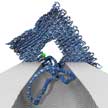 Over the past few decades, researchers have developed various optical voltage sensing probes in order to overcome the highly invasive nature of electrode-based techniques. These voltage sensing mechanisms can be hampered by some combination of limitations including low sensitivity, slow kinetics, or heavy capacitive loading. This has motivated a group of researchers to explore DNA nanotechnology for developing novel optical voltage sensing nanodevices that convert a local change of electric potential into optical signals.They now report that a voltage can be read out in a nanopore with a dedicated F�rster resonance energy transfer (FRET) sensor on a DNA origami.
Over the past few decades, researchers have developed various optical voltage sensing probes in order to overcome the highly invasive nature of electrode-based techniques. These voltage sensing mechanisms can be hampered by some combination of limitations including low sensitivity, slow kinetics, or heavy capacitive loading. This has motivated a group of researchers to explore DNA nanotechnology for developing novel optical voltage sensing nanodevices that convert a local change of electric potential into optical signals.They now report that a voltage can be read out in a nanopore with a dedicated F�rster resonance energy transfer (FRET) sensor on a DNA origami.
Mar 26th, 2018
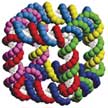 DNA, the fundamental building block of our genetic makeup, has become an intense nanotechnology research field. Nanotechnology researchers use it to create artificial rationally designed nanostructures for diverse applications in biology, chemistry, and physics. In a progress report, scientists focus on the different design paradigms (DNA origami and the related techniques are particularly emphasized), selected high-quality shapes, and the software that enable user-friendly design and fabrication of DNA nanoobjects.
DNA, the fundamental building block of our genetic makeup, has become an intense nanotechnology research field. Nanotechnology researchers use it to create artificial rationally designed nanostructures for diverse applications in biology, chemistry, and physics. In a progress report, scientists focus on the different design paradigms (DNA origami and the related techniques are particularly emphasized), selected high-quality shapes, and the software that enable user-friendly design and fabrication of DNA nanoobjects.
Feb 20th, 2018
 Hydrogen bond base pairing forces are essential for the mechanisms associated with DNA stability. Despite attracting great research attention, this fundamental interaction has eluded a precise physical description so far since its electrical origin has not been quantified yet. Researchers now have proposed characterization by means of electrical forces, providing a framework for universal characterization of hydrogen bonds. In this way, they provide technical arguments to support that hydrogen bonds are well distinguishable and their role in biological events require a proper specific intrabond description.
Hydrogen bond base pairing forces are essential for the mechanisms associated with DNA stability. Despite attracting great research attention, this fundamental interaction has eluded a precise physical description so far since its electrical origin has not been quantified yet. Researchers now have proposed characterization by means of electrical forces, providing a framework for universal characterization of hydrogen bonds. In this way, they provide technical arguments to support that hydrogen bonds are well distinguishable and their role in biological events require a proper specific intrabond description.
Oct 10th, 2017
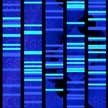 DNA is well known as the genetic material, but has also been used as a building block for the construction of nanoscale structures and periodic arrays. One other application is the storage of information in DNA. Such an information storage method has many advantages including longevity and ability for highly dense storage, and is more suited for archival storage of data. In new work, scientists use shape-changing DNA nanostructures for short term storage of data, where the information is 'written' in different conformations of the nanostructures. The stored data can be easily read-out using gel electrophoresis, eliminating any multi-step or costly methods.
DNA is well known as the genetic material, but has also been used as a building block for the construction of nanoscale structures and periodic arrays. One other application is the storage of information in DNA. Such an information storage method has many advantages including longevity and ability for highly dense storage, and is more suited for archival storage of data. In new work, scientists use shape-changing DNA nanostructures for short term storage of data, where the information is 'written' in different conformations of the nanostructures. The stored data can be easily read-out using gel electrophoresis, eliminating any multi-step or costly methods.
Sep 18th, 2017
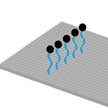 Synthetic nanomotors and DNA walkers, which mimic a cell's transportation system, are intricately designed systems that draw chemical energy from the environment and convert it into mechanical motion. Using such DNA walkers as signal amplifier for nucleic acids detection has only recently been reported. Researchers now report that they converted a DNA walker into a linear fluorescence signal amplifier on a rectangle DNA origami that can improve the detection of target molecules such as nucleic acids.
Synthetic nanomotors and DNA walkers, which mimic a cell's transportation system, are intricately designed systems that draw chemical energy from the environment and convert it into mechanical motion. Using such DNA walkers as signal amplifier for nucleic acids detection has only recently been reported. Researchers now report that they converted a DNA walker into a linear fluorescence signal amplifier on a rectangle DNA origami that can improve the detection of target molecules such as nucleic acids.
Aug 21st, 2017
 DNA is probably the most programmable biomaterial for creating a wide range of rationally designed and functionally enhanced nanostructures. The sophisticated, programmable, and addressable DNA nanostructures are strong candidates for constructing nanoelectronic devices. The size of DNA molecules is also key: DNA double-helix has a neighboring base pair distance of 0.34 nm and a diameter of 2.1 - 2.6 nm a, and thus DNA complex-based nanoelectronics may break the 5-nm processing limit of commercial silicon-based semiconductors.
DNA is probably the most programmable biomaterial for creating a wide range of rationally designed and functionally enhanced nanostructures. The sophisticated, programmable, and addressable DNA nanostructures are strong candidates for constructing nanoelectronic devices. The size of DNA molecules is also key: DNA double-helix has a neighboring base pair distance of 0.34 nm and a diameter of 2.1 - 2.6 nm a, and thus DNA complex-based nanoelectronics may break the 5-nm processing limit of commercial silicon-based semiconductors.
 Subscribe to our Nanotechnology Spotlight feed
Subscribe to our Nanotechnology Spotlight feed





